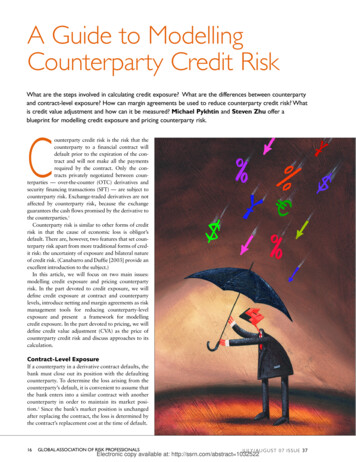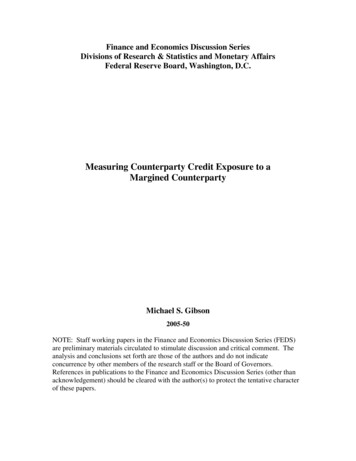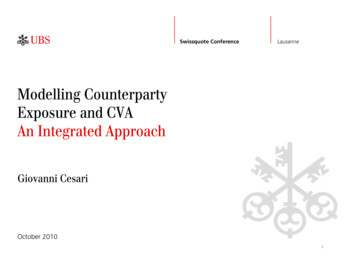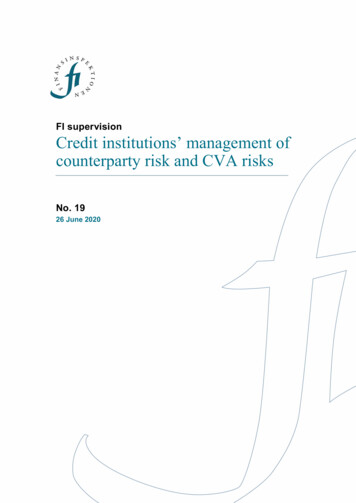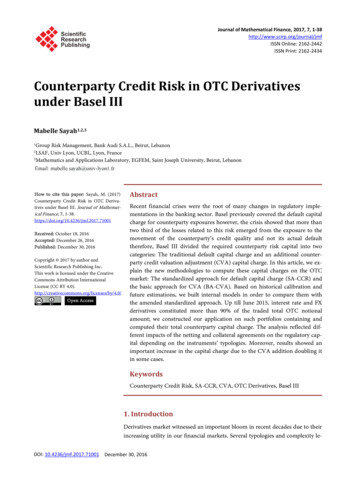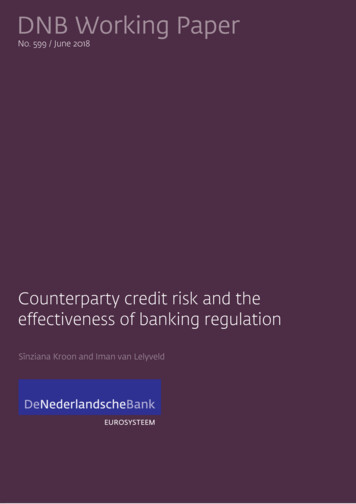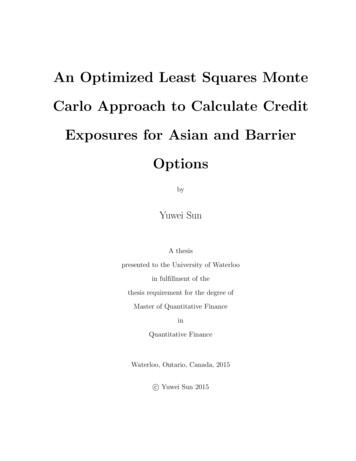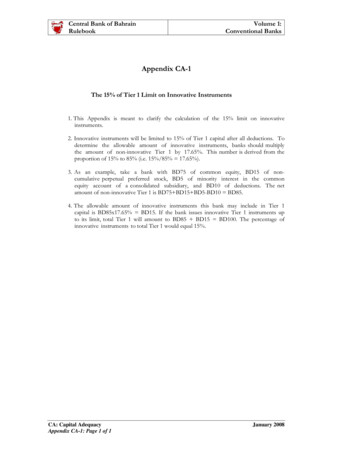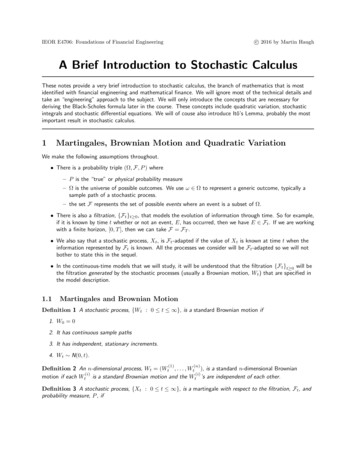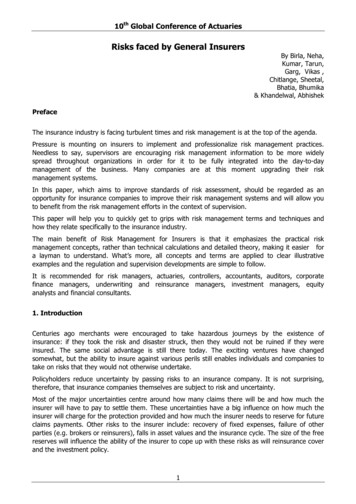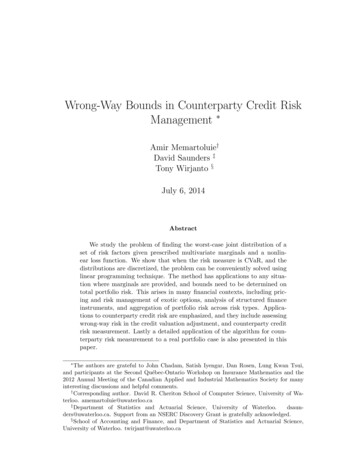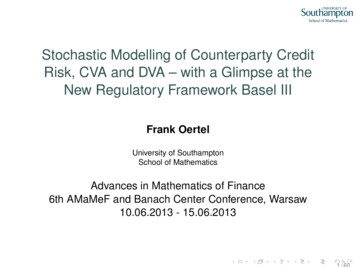
Transcription
Stochastic Modelling of Counterparty CreditRisk, CVA and DVA – with a Glimpse at theNew Regulatory Framework Basel IIIFrank OertelUniversity of SouthamptonSchool of MathematicsAdvances in Mathematics of Finance6th AMaMeF and Banach Center Conference, Warsaw10.06.2013 - 15.06.2013
DisclaimerThis presentation and associated materials are provided forinformational and educational purposes. Views expressed inthis work are the author’s views.
DisclaimerThis presentation and associated materials are provided forinformational and educational purposes. Views expressed inthis work are the author’s views.In particular, this presentation is by no means linked to anypresent and future wording regarding global regulation of CCRincluding EMIR and CRR (CRD IV).
Contents1 Simultaneous defaults and total bilateral counterparty creditrisk2 Total bilateral valuation adjustment3 Unilateral CVA and Basel III
1 Simultaneous defaults and total bilateral counterparty creditrisk2 Total bilateral valuation adjustment3 Unilateral CVA and Basel III
Counterparty credit risk - Outline ISuppose there are two parties who are trading a portfolio ofOTC derivative contracts such as, e. g., a portfolio of CDSs.(Bilateral) counterparty credit risk (CCR) is the risk that at leastone of those two parties in that derivative transaction willdefault prior to the expiration of the contract and will be unableto make all contractual payments to its counterpart.
Counterparty credit risk - Outline ISuppose there are two parties who are trading a portfolio ofOTC derivative contracts such as, e. g., a portfolio of CDSs.(Bilateral) counterparty credit risk (CCR) is the risk that at leastone of those two parties in that derivative transaction willdefault prior to the expiration of the contract and will be unableto make all contractual payments to its counterpart.Future cashflow exchanges are not known with certainty today.The main feature that distinguishes CCR from the risk of astandard loan is the uncertainty of the exposure at any futuredate. Hence, regarding the modelling of the exposure asimulation of future cashflow exchanges is necessary.
Counterparty credit risk - Outline IIWhat has to be analysed in CCR?
Counterparty credit risk - Outline IIWhat has to be analysed in CCR? Modelling of the “exposure”, i. e., the expected loss to aparty when their counterparty defaults before maturity ofthe financial contract;
Counterparty credit risk - Outline IIWhat has to be analysed in CCR? Modelling of the “exposure”, i. e., the expected loss to aparty when their counterparty defaults before maturity ofthe financial contract; Calculation of the default probability of each of the bothtrading parties (can be derived e. g. from CDS prices in themarket);
Counterparty credit risk - Outline IIWhat has to be analysed in CCR? Modelling of the “exposure”, i. e., the expected loss to aparty when their counterparty defaults before maturity ofthe financial contract; Calculation of the default probability of each of the bothtrading parties (can be derived e. g. from CDS prices in themarket); Analysis of a dependence between exposure and defaulttime (“Wrong-Way Risk” and “Right-Way-Risk”);
Counterparty credit risk - Outline IIWhat has to be analysed in CCR? Modelling of the “exposure”, i. e., the expected loss to aparty when their counterparty defaults before maturity ofthe financial contract; Calculation of the default probability of each of the bothtrading parties (can be derived e. g. from CDS prices in themarket); Analysis of a dependence between exposure and defaulttime (“Wrong-Way Risk” and “Right-Way-Risk”); Calculation of a value adjustment on top of the “CCR free”market value of a transaction, implying a “pricing of CCR”;
Counterparty credit risk - Outline IIWhat has to be analysed in CCR? Modelling of the “exposure”, i. e., the expected loss to aparty when their counterparty defaults before maturity ofthe financial contract; Calculation of the default probability of each of the bothtrading parties (can be derived e. g. from CDS prices in themarket); Analysis of a dependence between exposure and defaulttime (“Wrong-Way Risk” and “Right-Way-Risk”); Calculation of a value adjustment on top of the “CCR free”market value of a transaction, implying a “pricing of CCR”; Basel III capital charge for the “value adjustment volatilityrisk”;
Counterparty credit risk - Outline IIWhat has to be analysed in CCR? Modelling of the “exposure”, i. e., the expected loss to aparty when their counterparty defaults before maturity ofthe financial contract; Calculation of the default probability of each of the bothtrading parties (can be derived e. g. from CDS prices in themarket); Analysis of a dependence between exposure and defaulttime (“Wrong-Way Risk” and “Right-Way-Risk”); Calculation of a value adjustment on top of the “CCR free”market value of a transaction, implying a “pricing of CCR”; Basel III capital charge for the “value adjustment volatilityrisk”; Impact of central clearing through a CCP.
CCR - The framework IConsider two arbitrary parties who trade with each otheraccording to an underlying financial contract - “party 0” and“party 2”, say. Let k {0, 2} and T 0 the final maturity of thisfinancial contract.
CCR - The framework IConsider two arbitrary parties who trade with each otheraccording to an underlying financial contract - “party 0” and“party 2”, say. Let k {0, 2} and T 0 the final maturity of thisfinancial contract. Let X (X(t))0 t T denote a stochastic process describinga cash flow between party 0 and party 2 (or a randomsequence of prices). If, at time t, Xt is seen from the pointof view of party k, we denote its value equivalently as Xt (k)or Xt (k, 2 k) or Xk (t) - depending on its eligibility.
CCR - The framework IConsider two arbitrary parties who trade with each otheraccording to an underlying financial contract - “party 0” and“party 2”, say. Let k {0, 2} and T 0 the final maturity of thisfinancial contract. Let X (X(t))0 t T denote a stochastic process describinga cash flow between party 0 and party 2 (or a randomsequence of prices). If, at time t, Xt is seen from the pointof view of party k, we denote its value equivalently as Xt (k)or Xt (k, 2 k) or Xk (t) - depending on its eligibility. We will make use of the important notation Yt (k l) todescribe a random cash flow amount from the point of viewof party k at time t contingent on the default of party l,where l {0, 2}.
CCR - The framework II “Contingent cash flows” between two trading parties can beembedded into the model of a generalised weighted anddirected Erdős-Rényi random graph (“network”), consistingof counterparties as nodes and current exposures asedges, leading to matrix-valued stochastic processes oftype (ω, t) 7 A(ω, t), where A(ω, t)k,l : Yt (k l)(ω)describes a contingent cash flow between the nodes k andl, given that l will default until T (with probability 1).
CCR - The framework II “Contingent cash flows” between two trading parties can beembedded into the model of a generalised weighted anddirected Erdős-Rényi random graph (“network”), consistingof counterparties as nodes and current exposures asedges, leading to matrix-valued stochastic processes oftype (ω, t) 7 A(ω, t), where A(ω, t)k,l : Yt (k l)(ω)describes a contingent cash flow between the nodes k andl, given that l will default until T (with probability 1). Clearing through a central counterparty (CCP) changesthis graph to a (possibly disconnected) tree.
CCR - The framework II “Contingent cash flows” between two trading parties can beembedded into the model of a generalised weighted anddirected Erdős-Rényi random graph (“network”), consistingof counterparties as nodes and current exposures asedges, leading to matrix-valued stochastic processes oftype (ω, t) 7 A(ω, t), where A(ω, t)k,l : Yt (k l)(ω)describes a contingent cash flow between the nodes k andl, given that l will default until T (with probability 1). Clearing through a central counterparty (CCP) changesthis graph to a (possibly disconnected) tree. Notice that the permutation s : {0, 2} {0, 2}, k 7 2 kis bijective. It satisfies s s s. (If s should permute thenumbers 1 and 2 instead, then put s(k) : 3 k.)
Modelling of default timesLet τ0 denote the default time of the investor and τ2 the defaulttime of the counterparty. Suppose that the underlying financialmarket model is arbitrage-free. Let (Ω, G, G, Q) be a filteredprobability space (satisfying the usual conditions) such that forall t 0 the σ-algebra Gt contains both, the market informationup to time t and the information whether the default of theinvestor or its counterpart has occurred or not up to time t. Q isa (not necessarily unique) “spot martingale measure”.
Modelling of default timesLet τ0 denote the default time of the investor and τ2 the defaulttime of the counterparty. Suppose that the underlying financialmarket model is arbitrage-free. Let (Ω, G, G, Q) be a filteredprobability space (satisfying the usual conditions) such that forall t 0 the σ-algebra Gt contains both, the market informationup to time t and the information whether the default of theinvestor or its counterpart has occurred or not up to time t. Q isa (not necessarily unique) “spot martingale measure”.Let τ : min{τ0 , τ2 } (i. e., the “first-to-default time”). Both, τ0 andτ2 are G-stopping times.
Modelling of default timesLet τ0 denote the default time of the investor and τ2 the defaulttime of the counterparty. Suppose that the underlying financialmarket model is arbitrage-free. Let (Ω, G, G, Q) be a filteredprobability space (satisfying the usual conditions) such that forall t 0 the σ-algebra Gt contains both, the market informationup to time t and the information whether the default of theinvestor or its counterpart has occurred or not up to time t. Q isa (not necessarily unique) “spot martingale measure”.Let τ : min{τ0 , τ2 } (i. e., the “first-to-default time”). Both, τ0 andτ2 are G-stopping times. Consider the G-stopping timeτ : min{τ, T}. As we will see, a stochastic analysis of CCRbuilds on a consequent and repeated use of the positivefunctions x : max{x, 0} and x : x x ( x) max{ x, 0} (x R).
All possible bilateral CCR scenariosLet k {0, 2}. Consider the following sets:
All possible bilateral CCR scenariosLet k {0, 2}. Consider the following sets: N : {τ0 T and τ2 T} (i. e., both, party 0 and party 2 donot default until T);
All possible bilateral CCR scenariosLet k {0, 2}. Consider the following sets: N : {τ0 T and τ2 T} (i. e., both, party 0 and party 2 donot default until T); A k : {τk T and τk τ2 k } (i. e., party k defaults first -until T);
All possible bilateral CCR scenariosLet k {0, 2}. Consider the following sets: N : {τ0 T and τ2 T} (i. e., both, party 0 and party 2 donot default until T); A k : {τk T and τk τ2 k } (i. e., party k defaults first -until T); Ak : {τk T and τk τ2 k } A2 k : Asim (i. e., party 0and party 2 default simultaneously - until T).
All possible bilateral CCR scenariosLet k {0, 2}. Consider the following sets: N : {τ0 T and τ2 T} (i. e., both, party 0 and party 2 donot default until T); A k : {τk T and τk τ2 k } (i. e., party k defaults first -until T); Ak : {τk T and τk τ2 k } A2 k : Asim (i. e., party 0and party 2 default simultaneously - until T).Observation· ·Ω N · A 0 A2 Asim .
All possible bilateral CCR scenariosLet k {0, 2}. Consider the following sets: N : {τ0 T and τ2 T} (i. e., both, party 0 and party 2 donot default until T); A k : {τk T and τk τ2 k } (i. e., party k defaults first -until T); Ak : {τk T and τk τ2 k } A2 k : Asim (i. e., party 0and party 2 default simultaneously - until T).Observation· ·Ω N · A 0 A2 Asim . Moreover, N Gτ , A k Gτ and hence also c·Asim N · A A Gτ .02
Mark-to-Market value (MtM)The trading book of a bank is based on the principle of “fairvalue accounting” (FAS 157 (US), respectively IAS 39 (EU)). Itrefers to accounting for the “fair value” of an asset or liabilitybased on the current market price. Positions are “marked tomarket” on daily basis (via calibration of models to marketdata).
Mark-to-Market value (MtM)The trading book of a bank is based on the principle of “fairvalue accounting” (FAS 157 (US), respectively IAS 39 (EU)). Itrefers to accounting for the “fair value” of an asset or liabilitybased on the current market price. Positions are “marked tomarket” on daily basis (via calibration of models to marketdata).Deals are “fair” at the commencement of the financialtransaction. I. e., their net present value at t 0 equals zero:M(0) : NPV(0) : 0. However, as time goes by, the financialtransaction is “marked to market”, implying that at 0 t TM(t) NPV(t) 6 0.
Mark-to-Market value (MtM)The trading book of a bank is based on the principle of “fairvalue accounting” (FAS 157 (US), respectively IAS 39 (EU)). Itrefers to accounting for the “fair value” of an asset or liabilitybased on the current market price. Positions are “marked tomarket” on daily basis (via calibration of models to marketdata).Deals are “fair” at the commencement of the financialtransaction. I. e., their net present value at t 0 equals zero:M(0) : NPV(0) : 0. However, as time goes by, the financialtransaction is “marked to market”, implying that at 0 t TM(t) NPV(t) 6 0.Seen from t 0, M(t) : Ω R is a real-valued random variable(which can have a negative value if the trade is “out-of-themoney”).
Money conservation property IWe follow a basic accounting property according to which aliability for party k represents an asset for k’s counterparty 2 kitself (and conversely).
Money conservation property IWe follow a basic accounting property according to which aliability for party k represents an asset for k’s counterparty 2 kitself (and conversely). An important special case of the basicaccounting property is given by all processes satisfying theDefinition (Money Conservation Property)Let 0 t T and k {0, 2}. A cash flow X (Xt )0 t T betweentwo trading parties satisfies the Money Conservation Property(MCP) at t iff there exists k {0, 2} such thatXt (k) Xt (2 k) .
Money conservation property IMoreover, we follow a basic accounting property according towhich a liability for party k represents an asset for k’scounterparty 2 k itself (and conversely). An important specialcase of the basic accounting property is given by all processessatisfying theDefinition (Money Conservation Property)Let 0 t T and k {0, 2}. A cash flow X (Xt )0 t T betweentwo trading parties satisfies the Money Conservation Property(MCP) at t iff there exists k {0, 2} such thatXt (k, 2 k) Xt (2 k, k) .
Money conservation property IMoreover, we follow a basic accounting property according towhich a liability for party k represents an asset for k’scounterparty 2 k itself (and conversely). An important specialcase of the basic accounting property is given by all processessatisfying theDefinition (Money Conservation Property)Let 0 t T and k {0, 2}. A cash flow X (Xt )0 t T betweentwo trading parties satisfies the Money Conservation Property(MCP) at t iff there exists k {0, 2} such that Xt (k, 2 k) Xt (2 k, k) A 0 for all A {A 0 , A2 , Asim , N} .
Money conservation property IIIn particular, (at t) such “MCP processes” X satisfy the followingimportant property in relation to CCR: Xt (k, 2 k) Xt (2 k, k) k {0, 2}
Money conservation property IIIn particular, (at t) such “MCP processes” X satisfy the followingimportant property in relation to CCR: Xt (k, 2 k) Xt (2 k, k) k {0, 2}Standing AssumptionAny “non-vulnerable” cash flow (i. e., any cash flow which is notaccounting for CCR) is assumed to satisfy the MCP at anyt [0, T].
Money conservation property IIIn particular, (at t) such “MCP processes” X satisfy the followingimportant property in relation to CCR: Xt (k, 2 k) Xt (2 k, k) k {0, 2}Standing AssumptionAny “non-vulnerable” cash flow (i. e., any cash flow which is notaccounting for CCR) is assumed to satisfy the MCP at anyt [0, T].ExampleThe following processes do not satisfy the MCP at t:
Money conservation property IIIn particular, (at t) such “MCP processes” X satisfy the followingimportant property in relation to CCR: Xt (k, 2 k) Xt (2 k, k) k {0, 2}Standing AssumptionAny “non-vulnerable” cash flow (i. e., any cash flow which is notaccounting for CCR) is assumed to satisfy the MCP at anyt [0, T].ExampleThe following processes do not satisfy the MCP at t:(i) Yt (k, 2 k)(ω) : 11A (ω) 11A (ω) sin(t)LGDk ;k2 k
Money conservation property IIIn particular, (at t) such “MCP processes” X satisfy the followingimportant property in relation to CCR: Xt (k, 2 k) Xt (2 k, k) k {0, 2}Standing AssumptionAny “non-vulnerable” cash flow (i. e., any cash flow which is notaccounting for CCR) is assumed to satisfy the MCP at anyt [0, T].ExampleThe following processes do not satisfy the MCP at t:(i) Yt (k, 2 k)(ω) : 11A (ω) 11A (ω) sin(t)LGDk ;k2 k(ii) Λt (k, 2 k) : Mk (t) LGD2 k (Mk (t)) .
Representation of the MtM value M FTAP IFix k {0, 2} and let 0 s t T.
Representation of the MtM value M FTAP IFix k {0, 2} and let 0 s t T. Consider the randomvariableZ(s,t] 1Πk : D(0, s)D(0, u)dΦk (u) ,(s,t]where Φk (viewed from party k) denotes a non-vulnerablecumulative dividend process of the portfolio over the timehorizon [s, t] and D(0, ·) a continuous G-adapted discount factorprocess (which both are assumed to be of finite variation).
Representation of the MtM value M FTAP IFix k {0, 2} and let 0 s t T. Consider the randomvariableZ(s,t] 1Πk : D(0, s)D(0, u)dΦk (u) ,(s,t]where Φk (viewed from party k) denotes a non-vulnerablecumulative dividend process of the portfolio over the timehorizon [s, t] and D(0, ·) a continuous G-adapted discount factorprocess (which both are assumed to be of finite variation).R(s,t]D(0, s)Πk (s,t] D(0, u)dΦk (u) represents the sum of allcumulatively discounted future cash flows of the portfoliobetween s and t not accounting for CCR (seen from the point ofview of party k).
Representation of the MtM value M FTAP IFix k {0, 2} and let 0 s t T. Consider the randomvariableZ(s,t] 1Πk : D(0, s)D(0, u)dΦk (u) ,(s,t]where Φk (viewed from party k) denotes a non-vulnerablecumulative dividend process of the portfolio over the timehorizon [s, t] and D(0, ·) a continuous G-adapted discount factorprocess (which both are assumed to be of finite variation).R(s,t]D(0, s)Πk (s,t] D(0, u)dΦk (u) represents the sum of allcumulatively discounted future cash flows of the portfoliobetween s and t not accounting for CCR (seen from the point of(v,t]view of party k). Hence, Πk 0 for all v [t, T].
Representation of the MtM value M FTAP IFix k {0, 2} and let 0 s t T. Consider the randomvariableZ(s,t] 1Πk : D(0, s)D(0, u)dΦk (u) ,(s,t]where Φk (viewed from party k) denotes a non-vulnerablecumulative dividend process of the portfolio over the timehorizon [s, t] and D(0, ·) a continuous G-adapted discount factorprocess (which both are assumed to be of finite variation).R(s,t]D(0, s)Πk (s,t] D(0, u)dΦk (u) represents the sum of allcumulatively discounted future cash flows of the portfoliobetween s and t not accounting for CCR (seen from the point of(v,t]view of party k). Hence, Πk 0 for all v [t, T]. Notice that(s,t](s,t]Φk Φ2 k and hence Πk Π2 k for all 0 s t T (dueto the MCP).
Representation of the MtM M value FTAP IIAssume throughout that our financial market model does notallow arbitrage and that each CCR free contingent claimbetween party k and party 2 k in the portfolio (or netting set)is attainable therein.
Representation of the MtM M value FTAP IIAssume throughout that our financial market model does notallow arbitrage and that each CCR free contingent claimbetween party k and party 2 k in the portfolio (or netting set)is attainable therein. Thus, seen from party k’s point of view theCCR free mark-to-market processMk (Mk (t))0 t T (Mt (k))0 t T is then given by"Z#hi(t,T]QQD(t, u)dΦk (u) Gt M2 k (t) ,Mk (t) E Πk Gt E(t,T]where Q is a “spot martingale measure” (due to the risk-neutralvaluation formula). In the following we fix Q and occasionallyomit its extra description in the notation of (conditional)expectation operators.
The main CCR building blocks(t,u]Πk(t,u] Π2 kRandom CCR free cumulative cashflow from the claim in (t, u], discountedto time t – seen from k’s point of view
The main CCR building blocks(t,u]Πk(t,u] Π2 k(t,T]Mk (t) EQ [Πk Gt ] M2 k (t)Random CCR free cumulative cashflow from the claim in (t, u], discountedto time t – seen from k’s point of view(t,u]Random NPV (or MtM) of Πk – represented as conditional expectationw.r.t. Q, given the “information” Gt
The main CCR building blocks(t,u]Πk(t,u] Π2 k(t,T]Mk (t) EQ [Πk Gt ] M2 k (t)0 Rk 1Random CCR free cumulative cashflow from the claim in (t, u], discountedto time t – seen from k’s point of view(t,u]Random NPV (or MtM) of Πk – represented as conditional expectationw.r.t. Q, given the “information” Gtk’s (random) recovery rate; i. e., theportion of the payoff from the MtMpaid by party k to party 2 k incase of k’s default
The main CCR building blocks(t,u]Πk(t,u] Π2 k(t,T]Mk (t) EQ [Πk Gt ] M2 k (t)0 Rk 10 LGDk : 1 Rk 1Random CCR free cumulative cashflow from the claim in (t, u], discountedto time t – seen from k’s point of view(t,u]Random NPV (or MtM) of Πk – represented as conditional expectationw.r.t. Q, given the “information” Gtk’s (random) recovery rate; i. e., theportion of the payoff from the MtMpaid by party k to party 2 k incase of k’s defaultk’s (random) Loss Given Default
The main CCR building blocks(t,u]Πk(t,u] Π2 k(t,T]Mk (t) EQ [Πk Gt ] M2 k (t)0 Rk 10 LGDk : 1 Rk 1D(t, u) : D(0, u)/D(0, t)Random CCR free cumulative cashflow from the claim in (t, u], discountedto time t – seen from k’s point of view(t,u]Random NPV (or MtM) of Πk – represented as conditional expectationw.r.t. Q, given the “information” Gtk’s (random) recovery rate; i. e., theportion of the payoff from the MtMpaid by party k to party 2 k incase of k’s defaultk’s (random) Loss Given Defaultdiscount factor at time t for time u t(can be random)
Valuation of defaultable claims IDefaultable claims can be valued by interpreting them asportfolios of claims between non-defaultable counterpartiesincluding the riskless claim and mutual default protectioncontracts. Let k {0, 2}. Seen e. g. from the point of view ofparty k the latter says:Party k sells to party 2 k default protection on party 2 kcontingent to an amount specified by an ISDA close-out rule.
Valuation of defaultable claims IDefaultable claims can be valued by interpreting them asportfolios of claims between non-defaultable counterpartiesincluding the riskless claim and mutual default protectioncontracts. Let k {0, 2}. Seen e. g. from the point of view ofparty k the latter says:Party k sells to party 2 k default protection on party 2 kcontingent to an amount specified by an ISDA close-out rule.Let t [0, T] such that ]]t, τ ]] 6 . Let Mt (k) be the mark-to-market value to party k in case both,party k and party 2 k do not default until T; CVAt (k 2 k) be the value of default protection that party ksells to party 2 k contingent on the default of party 2 k.
Valuation of defaultable claims IIAt t party k requires a payment of the “CCR risk premium”CVAt (k 2 k) from party 2 k to be compensated for the risk ofa default of party 2 k.
Valuation of defaultable claims IIAt t party k requires a payment of the “CCR risk premium”CVAt (k 2 k) from party 2 k to be compensated for the risk ofa default of party 2 k. Conversely, party 2 k requires apayment of CVAt (2 k k) from party k to be compensated forthe risk of a default of party k.
Valuation of defaultable claims IIAt t party k requires a payment of the “CCR risk premium”CVAt (k 2 k) from party 2 k to be compensated for the risk ofa default of party 2 k. Conversely, party 2 k requires apayment of CVAt (2 k k) from party k to be compensated forthe risk of a default of party k. Note that Asim 6 is not explicitlyexcluded!
Valuation of defaultable claims IIAt t party k requires a payment of the “CCR risk premium”CVAt (k 2 k) from party 2 k to be compensated for the risk ofa default of party 2 k. Conversely, party 2 k requires apayment of CVAt (2 k k) from party k to be compensated forthe risk of a default of party k. Note that Asim 6 is not explicitlyexcluded! Therefore, given the MCP party k reports at t the“bilaterally CCR-adjusted” value (defined as “fair value” in FAS157):
Valuation of defaultable claims IIAt t party k requires a payment of the “CCR risk premium”CVAt (k 2 k) from party 2 k to be compensated for the risk ofa default of party 2 k. Conversely, party 2 k requires apayment of CVAt (2 k k) from party k to be compensated forthe risk of a default of party k. Note that Asim 6 is not explicitlyexcluded! Therefore, given the MCP party k reports at t the“bilaterally CCR-adjusted” value (defined as “fair value” in FAS157):k offers a payment of Mt (k) to start a deal with 2 k .
Valuation of defaultable claims IIAt t party k requires a payment of the “CCR risk premium”CVAt (k 2 k) from party 2 k to be compensated for the risk ofa default of party 2 k. Conversely, party 2 k requires apayment of CVAt (2 k k) from party k to be compensated forthe risk of a default of party k. Note that Asim 6 is not explicitlyexcluded! Therefore, given the MCP party k reports at t the“bilaterally CCR-adjusted” value (defined as “fair value” in FAS157):2 k rejects and requires Mt (k) CVAt (2 k k) instead .
Valuation of defaultable claims IIAt t party k requires a payment of the “CCR risk premium”CVAt (k 2 k) from party 2 k to be compensated for the risk ofa default of party 2 k. Conversely, party 2 k requires apayment of CVAt (2 k k) from party k to be compensated forthe risk of a default of party k. Note that Asim 6 is not explicitlyexcluded! Therefore, given the MCP party k reports at t the“bilaterally CCR-adjusted” value (defined as “fair value” in FAS157): Mt (k) CVAt (2 k k) ?
Valuation of defaultable claims IIAt t party k requires a payment of the “CCR risk premium”CVAt (k 2 k) from party 2 k to be compensated for the risk ofa default of party 2 k. Conversely, party 2 k requires apayment of CVAt (2 k k) from party k to be compensated forthe risk of a default of party k. Note that Asim 6 is not explicitlyexcluded! Therefore, given the MCP party k reports at t the“bilaterally CCR-adjusted” value (defined as “fair value” in FAS157):k offers a payment of Mt (k) CVAt (2 k k) CVAt (k 2 k), i. e.,
Valuation of defaultable claims IIAt t party k requires a payment of the “CCR risk premium”CVAt (k 2 k) from party 2 k to be compensated for the risk ofa default of party 2 k. Conversely, party 2 k requires apayment of CVAt (2 k k) from party k to be compensated forthe risk of a default of party k. Note that Asim 6 is not explicitlyexcluded! Therefore, given the MCP party k reports at t the“bilaterally CCR-adjusted” value (defined as “fair value” in FAS157): k offers a payment of Mt (k) CVAt (k 2 k) CVAt (2 k k) : Vt (k) .
Valuation of defaultable claims IIAt t party k requires a payment of the “CCR risk premium”CVAt (k 2 k) from party 2 k to be compensated for the risk ofa default of party 2 k. Conversely, party 2 k requires apayment of CVAt (2 k k) from party k to be compensated forthe risk of a default of party k. Note that Asim 6 is not explicitlyexcluded! Therefore, given the MCP party k reports at t the“bilaterally CCR-adjusted” value (defined as “fair value” in FAS157): (!) Vt (k) Mt (k) CVAt (k 2 k) CVAt (2 k k) Vt (2 k) ;
Valuation of defaultable claims IIAt t party k requires a payment of the “CCR risk premium”CVAt (k 2 k) from party 2 k to be compensated for the risk ofa default of party 2 k. Conversely, party 2 k requires apayment of CVAt (2 k k) from party k to be compensated forthe risk of a default of party k. Note that Asim 6 is not explicitlyexcluded! Therefore, given the MCP party k reports at t the“bilaterally CCR-adjusted” value (defined as “fair value” in FAS157): (!) Vt (k) Mt (k) CVAt (k 2 k) CVAt (2 k k) Vt (2 k) ;Hence, the deal between k and 2 k is agreed!
CCR - Closing out practice ISuppose, party k defaults (first).
CCR - Closing out practice ISuppose, party k defaults (first).The surviving party 2 k should then evaluate all terminatedtransactions to claim for at least a partial reimbursement (afterthe application of “netting rules”) to fix the transactions(including the collateral).
CCR - Closing out practice ISuppose, party k defaults (first).The surviving party 2 k should then evaluate all terminatedtransactions to claim for at least a partial reimbursement (afterthe application of “netting rules”) to fix the transactions(including the collateral).In order to maintain its market position, party k enters into asimilar financial contract with another counterparty.
CCR - Closing out practice ISuppose, party k defaults (first).The surviving party 2 k should then evaluate all terminatedtransactions to claim for
Counterparty credit risk - Outline I Suppose there are two parties who are trading a portfolio of OTC derivative contracts such as, e.g., a portfolio of CDSs. (Bilateral) counterparty credit risk (CCR)is the risk that at least one of those two parties in that derivative transaction will default prior to the expiration of the contract and will .
